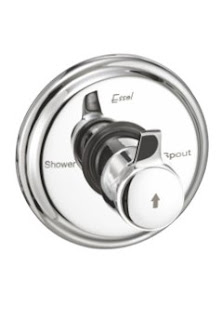Diverter Valves
It's important to know how appliances and systems in your house function so you know what to do if something doesn't work as expected. Diverter valves may sound like something complex, but understanding their purpose is easy. Below, you’ll find some basic knowledge about what a diverter valve is, why it’s important, and how it works.
What Is a Diverter Valve?
If you aren't sure what a diverter valve is, think of it as an essential piece of your home’s water system. The easiest way to describe the functionality of a diverter valve is by using a simple example—in a shower/tub combo, when you turn the knob on your shower faucet to redirect water from the tub spout to the showerhead, you’ve used a shower diverter valve. A simple pull of a handle or pin will engage a rubber stopper that will change the direction of the water flow. This action creates pressure that forces the water up from the tub faucet toward the showerhead, allowing you to enjoy a hot shower in your bathtub.
If you’re wondering, “how does a diverter valve work,” the answer is simple. The valve's job is to do exactly what its name says: to divert the water flow from one place to another. Although it’s a handy piece of plumbing hardware that quickly changes the water direction, a diverter valve has other uses, too. These valves open and close pathways, allowing hot water to travel not only to domestic hot water systems like showers and taps but also to radiators.
It's important to note that a mixer valve isn't the same as a diverter valve. When it comes to diverter vs. mixer valves, the biggest difference between them is that you’ll need to install a mixer valve only if you want to change the outlet from which the water is coming.
Different Types of Diverter Valves
When talking about a shower diverter valve, there are three different types: the tee diverter, two-valve diverter, and three-valve diverter.
A tee diverter is a simple straight-pull handle that directs water to the showerhead. You can stop the water from running by pushing the tee back down after you’re done using the shower.
A two-valve diverter is fitted using two L-shaped valves found in the center of a standard faucet. A two-valve diverter adjusts the water temperature with a single dial found in the middle of the two temperature taps.
A three-valve diverter is installed on two-tap faucets. When the hot and cold water taps are turned on and the water mixes to the desired temperature, the water flows out of the third faucet, a showerhead for example, by turning the diverter. You can switch it off by turning it counter-clockwise to return it to its original position.
How Does the Diverter Valve Work in Heating Systems?
A diverter valve that works with a home’s heating system is located in a combination boiler (also called a combi boiler), which combines space heating and domestic hot water into a single unit; no separate water heater is required. If your home has a combi boiler, it prioritizes the water flow in your home's system, depending on the water source you use at a certain moment. The diverter valve is an essential element of this system because it controls the water flow through your home’s showerheads, taps, and heating system.
How to Install a New Shower Diverter Valve
Now that you know where diverter valves are located, the first thing you’ll need to do is remove your old shower head. Showerheads can tighten over time as far as their grip goes. In that case, a wrench can help you remove it. After removing the old showerhead, place the new diverter into position in the pipe. Make sure the diverter is secured by screwing it tightly into place to prevent potential water pressure loss and leakage.
Upon securing the valve, start re-installing the showerhead by placing it into the diverter valve. The next step is to place the handheld showerhead into the other part of the valve and to secure it in its position firmly. Make sure that everything is fitted tightly to prevent potential leaks. Finally, perform a test by switching the valve to see if there are any leaks.
Diverter Valve Maintenance and Repair
Reduce wear and strain on your shower diverter to prevent any need for repairs. Maintenance is key. Always make sure that you release the diverter, so it will let the water flow from the tub faucet for several seconds before you completely turn off the water.
If you’re wondering how to adjust a diverter valve or fix a broken one, the solution is often as simple as tightening some screws behind the valve’s faceplate.




Comments
Post a Comment